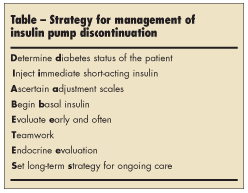What Next When an Insulin Pump Is Stopped?
Diabetes Q&A
On the Alpha and the Omega of the Beta Cell (and More)
Q: What is the safest approach to discontinuation of insulin pump therapy?
A: Many persons with diabetes mellitus, particularly those with type 1, are completely dependent on exogenous insulin to sustain vital functions, even life itself, and without it may rapidly experience systemic metabolic decompensation. Persons who have an insulin pump rarely take long-acting insulin products, so an acute interruption of insulin delivery could have sudden, possibly catastrophic consequences, such as intracellular acidosis, extreme hyperglycemia, and organ failure.
Insulin pump therapy is frequently interrupted in a number of scenarios, both unintentional and intentional. The infusion set may become inactive as a result of trauma, kinking, or obstruction, or it may simply run out of insulin because of patient forgetfulness, confusion, poor communication to health care providers, or lack of availability of a replacement set. Pumps may be discontinued in preparation for inpatient or outpatient procedures, radiologic tests, or surgery, or simply when patients are admitted to an emergency department or inpatient bed.
 When insulin pump therapy stops, clinicians and patients need to adjust treatment rapidly and effectively to prevent problems caused by acute insulin withdrawal. Often patients have established “backup orders,” and all inpatient order sets pertaining to insulin pump management should have provisions for a backup plan.1 The Table presents a systematic strategy for appropriate management when an insulin pump is stopped.
When insulin pump therapy stops, clinicians and patients need to adjust treatment rapidly and effectively to prevent problems caused by acute insulin withdrawal. Often patients have established “backup orders,” and all inpatient order sets pertaining to insulin pump management should have provisions for a backup plan.1 The Table presents a systematic strategy for appropriate management when an insulin pump is stopped.
Determination of the clinical status of the patient includes acute assessment of underlying illness, mental status, and whether there is clinical evidence of glucose toxicity, acidosis, or hypoglycemia. If a patient is critically ill, is undergoing surgery, or requires pressor therapy, intravenous insulin will likely be needed instead of subcutaneous dosing. Insulin pump therapy is not advised in the intensive care unit setting or in patients with ketoacidosis. Alternatively, if the patient is clinically stable, particularly one who has type 2 diabetes, and the insulin pump can be restarted quickly, then little intervention may be necessary.
Usually, patients will require immediate short-acting insulin to cover 75% to 100% of their pump basal dose as well as a correction bolus as outlined by the pump settings. Administration of this basal dose could also be appropriate with scheduled brief (more than 1 hour) discontinuation,
such as during a procedure. For example, if the pump basal rate is 1 unit per hour and the patient is taking aspart, lispro, or glulisine insulin, which generally are clinically effective for about 4 hours, then the patient would need about 3 to 4 units of basal insulin every 4 hours. The lower adjustment dose would be more desirable if the primary goal is to minimize any risk of hypoglycemia. If the insulin pump is expected to be discontinued for a more extended period, the short-acting insulin would need to be given for immediate replacement until a longer-acting insulin, such as NPH, glargine, or detemir, would have time to be absorbed and become clinically active.
The correction scale, or sensitivity index, is the basis for any “sliding scale” insulin that will be needed to treat hyperglycemic excursions. Mealtime dosing could continue either by means of patient carbohydrate counting or by using the known ratio to estimate requirements based on anticipated carbohydrate intake. In the case of intermittent or enteral feeding tube nutrition, a long-acting insulin dose could be adjusted to meet the calculated carbohydrate-associated needs.
Any abrupt change in insulin therapy requires attention, monitoring, and planning. Efforts need to be coordinated among the physicians, nursing staff, pharmacy staff, dietary staff, persons involved with procedures, and the patients. Consultation from a diabetologist/endocrinologist can help the team to work together to develop an effective long-term plan to improve safety and overall glycemic control. ■
1. Dalton MF, Klipfel L, Carmichael K. Safety issues: use of continuous subcutaneous insulin infusion (CSII) pumps in hospitalized patients. Hosp Pharm. 2006;41:956-969.
| Editor’s note: For additional information on insulin pump therapy, see “Getting Started With an Insulin Pump” (CONSULTANT, April 2009, page 223). |


